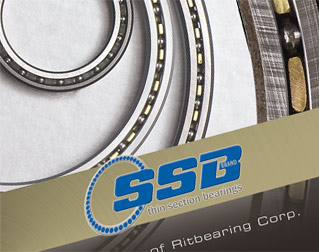Proper relubrication of your thin section bearings can help you extend the life and performance of your parts. However, there are some scenarios where regular maintenance and bearing lubrication are either difficult to perform – or even outright impossible.
In those cases, you’ll need to find an alternative to ensure that your bearings perform without ongoing support. Fortunately, there are some options available for situations where relubrication just isn’t going to happen.
Solid Lubricant
A solid lubricant is a good option for any thin section bearing that won’t receive any maintenance during its lifespan. Solid lubes utilize a porous, sponge-like polymer that’s added to the bearing to provide a lifetime supply of oil over time. As the parts run, the lubricant will release the proper amount of oil so that the bearing can operate without issue.
In addition to providing a lubrication option for impossible or hard-to-reach parts, another advantage of solid lubricants is that they’re a relatively clean solution. Solid lubes can be made with food-grade or other specialty oils and won’t leak like some standard greases, which makes it a good fit for applications that can’t afford lubricant spills or other issues.
Oil Baths
Depending on your application, you may be able to utilize an oil bath to keep bearings regularly lubricated in out-of-reach areas. An oil bath uses a reservoir that’s either fully or partially filled with oil to allow running parts to effectively lubricate themselves over time.
Essentially, the bearing or some other rotating part is partially submerged in the oil. As that part rotates, it draws oil up and lubricates itself while splashing excess oil onto the other parts within an enclosed space, such as a gearbox. This method can help you limit the number of times the oil is refilled or provide the application with the lubrication it needs before the entire unit is retired.
Sealed Bearings
A sealed thin section bearing is another potential option for an application where relubrication is either difficult or impossible. These parts have built-in closures to protect the inside of the bearings from dirt, water, and other potential contaminants. However, this seal would also require you to dismantle the part to add more lubrication. As a result, manufacturers include enough lubrication within the part for it to last for the expected lifetime of the bearing.
While a sealed bearing may not provide the same lifespan as a properly maintained and regularly lubricated open part, it can be a good solution for situations where maintenance isn’t realistic. If your bearing’s life calculation matches up with your expectations, a sealed bearing’s lubrication will last for as long as you need that individual part.
Invest in the Right Bearings and Lubricants for Your Applications
There is no single best thin section bearing out there, but there is a right choice based on your applications needs. SSB can work with you to determine which style of thin section bearing matches your lubrication limitations, whether that means one of our available styles or engineering a custom thin section bearing around your specific design.
Ready to invest in bearings that are right for your performance needs and budget? Contact us today to talk to our experts about your bearings needs today.










